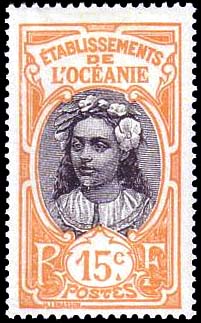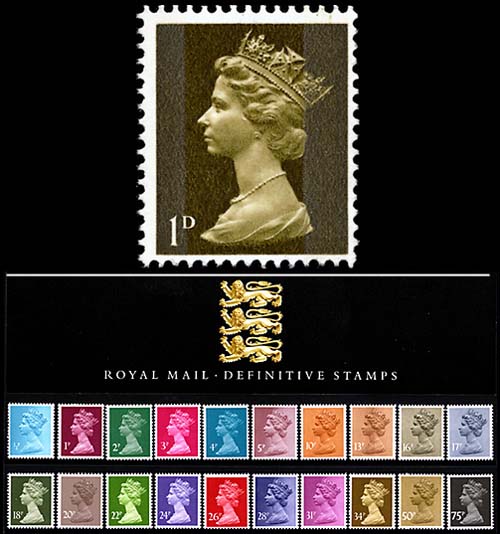Insights
insights
Britain's Machin definitive series has it all
By Michael Baadke
Last week's Refresher Course column discussed definitive stamps, the stamps that normally remain on sale for a long time at post offices and are sent to press repeatedly as the need arises.
Many countries make their definitive stamps fairly plain and small, usually in an effort to save on production costs. Even so, many stamp collectors find definitives to be the most fascinating type of stamp to collect. When a single design is used again and again over many years, it often becomes possible to find interesting varieties among the stamps that are created.
One of the most well-known definitive stamp series in the world began in Great Britain in 1967 and it will continue into the 21st century. The stamp designs are about as simple as can be, showing a left-facing profile portrait of Queen Elizabeth II and a number indicating the postage value of the stamp.
The portrait was originally created in plaster by artist Arnold Machin (pronounced "MAY-chin") when the queen was approaching age 40. In tribute to the classic design, these British definitives are most commonly referred to as Machins.
One of the earlier stamps of this series, the 1-penny issue of 1968, is shown at the top of Figure 1. Notice that the denomination is expressed as "1d." The letter "d" represents "penny" on British stamps issued in sterling currency values. Following a national changeover to decimal currency in 1971, British stamps began using the letter "p" to indicate penny values.
The bottom of Figure 1 shows a presentation pack from Royal Mail (the British post office), a special package of 20 Machin definitives bearing different denominations ranging from ½p to 75p.
This is but a fraction of the many Machin definitives that have been issued: The Scott Standard Postage Stamp Catalogue lists more than 500 major varieties of Machin stamps. Specialist collectors will tell you that there are many more varieties to be found once you begin looking closely at these stamps.
Although the majority of the Machin definitives resemble the simple stamp shown at the top of Figure 1, a number of different design varieties exist. Several are shown together in Figure 2.
The top three stamps in the illustration are small definitives issued in 1979 (2p at top left), 1990 (15p at top center with an added portrait of Queen Victoria to mark the 150th anniversary of British postage stamps), and 2000 (top right, showing a revised and enlarged portrait of the queen).
The next row of stamps shows a horizontally oriented self-adhesive Machin issued in 1997, an engraved 10p medium-size stamp from 1970, and an even larger high-value £2 stamp from 1977.
The four stamps pictured at the bottom of Figure 2 each include a national symbol in the design that identifies the stamp as a regional issue, sold predominantly in a specific area of the United Kingdom but valid for postage throughout the land. From left to right are stamps from Northern Ireland, Scotland, Wales & Monmouthshire, and the Isle of Man.
These designs are obvious varieties in the Machin series. More subtle varieties become apparent with closer examination of the stamps.
Though most Machin stamps are printed using etched gravure cylinders, others have been printed by nearly every process imaginable, including with intaglio plates made from line-engraved designs and, more commonly, by the transfer process of offset lithography.
Distinguishing the small differences between stamps printed by the various methods often requires close examination under magnification.
Machin stamps are also printed with phosphor-bar overprints of various widths. These usually transparent coatings are placed in various positions on the stamps to aid automatic mail-sorting machinery. The phosphor coating can be seen when it is exposed to ultraviolet light, and sometimes it is faintly visible under ordinary light.
Color and shade varieties are plentiful in this series, and they can be very subtle. The Scott catalog lists five colors for the 4p value alone: olive bister, greenish blue, bright greenish blue, bright blue and Prussian blue.
Small variations in the queen's portrait also distinguish certain varieties.
The Scott catalog points out that many Machin stamps are found with the numerals of value printed in varying widths. Figure 3 shows the 75p black with wide numerals from 1984 (left) and the revised 75p black with narrow numerals from 1988 (right).
Specialist collectors also look at varieties in paper, gum type, perforation and more.
Most Machin stamps are sold as post-office panes, but many also have been created in coil or booklet form.
British coil stamps are often created in multivalue formats that contain more than one denomination. Shown at the top of Figure 4 is a strip of five stamps from a 1969 coil consisting of two 2d stamps, one 3d, one 1d and one 4d. This pattern repeats throughout the coil.
United States collectors will note that the coil stamps are not straight-edged at top and bottom like most U.S. coil stamps. Still, British coil stamps can be identified with magnification because two parallel sides (either top and bottom or left and right) will show that the perforations have been precisely cut by a machine, not separated by hand-tearing.
The bottom illustration in Figure 4 shows eight Machin stamps in four denominations surrounding a Peter Rabbit label in a 1993 prestige booklet, a booklet with a specific topical theme.
The Machin portrait of Queen Elizabeth even appears on postal issues that some collectors might not think of as being Machins, but they are.
The top of Figure 5 shows a £2 stamp issued in 1988 as part of a high-value four-stamp Historic Castles definitive set. The £1 and £2 stamps show Machin's left-facing portrait of the queen, while the £1.50 and £5 values surprisingly show the same portrait reversed so the queen faces to the right.
The Machin design also appears on British postal cards, letter cards, envelopes and aerograms. Shown in Figure 5 are a 10½p aerogram and a 3½p letter card (with added 1p Machin definitive stamp).
The collector who has an interest in Machin definitives will find that collecting them is a challenging endeavor, but there are many wonderful resources to turn to for information.
The Scott catalog, with Machin listings following the standard listings for British stamps, provides a very basic starting point. Several British catalogs, including Stanley Gibbons and Stoneham, give additional details about varieties found in the series.
The Complete Deegam Machin Handbook by D.G.A. Myall is the authoritative reference work for collectors of this remarkable series. At more than 500 pages, this comprehensive guide is much more than the handbook suggested in the title. It provides a very thorough review of these appealing stamps and gives the reader a clear, ample introduction to many basic details about postage stamp creation and production in general.
Linn's readers can also rely upon top-notch occasional articles about the Machin definitives in the monthly Great Britain column. Writers David Alderfer and Larry Rosenblum cover all aspects of British stamps and collecting, but they regularly visit the Machin stamps with keen insights into areas of particular interest to collectors.
MORE RELATED ARTICLES
Headlines
-
US Stamps
Oct 7, 2024, 3 PMMcMurtrie dismissed as APS education director following Sept. 21 arrest
-
US Stamps
Oct 7, 2024, 12 PMVasiliauskas named president of Mystic Stamp Co.
-
US Stamps
Oct 6, 2024, 5 PMApgar souvenir card available
-
US Stamps
Oct 6, 2024, 4 PMFirst Continental Congress and U.N. stamps receive Scott catalog numbers

